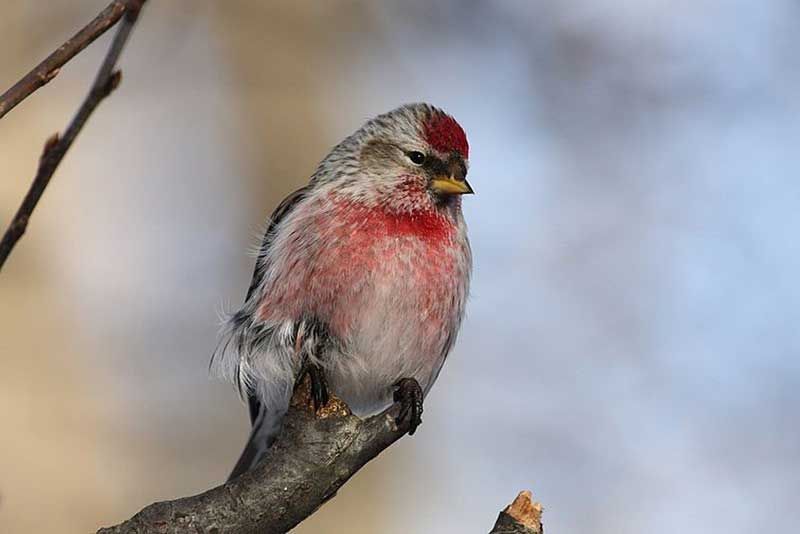Jan 28, 2015
By Steve Blight
It’s midwinter here in the Land O’Lakes, and the birds coming to the feeders at our house have settled into a fairly regular pattern. There is the usual flock of six to eight Black-capped Chickadees, a few noisy Blue Jays, the odd Downy and Hairy Woodpecker, and a couple of White-breasted Nuthatches. We can pretty much count on seeing all of these birds every day, as long as the feeders are well stocked with suet and sunflower seeds. Earlier this winter we had a nice flock of American Goldfinches that stayed with us for a couple of weeks, and they were joined for a few days by a small group of American Tree Sparrows, but both of these species seem to have moved on.
Late one afternoon in November a Barred Owl dropped by, and in December both a Cooper’s Hawk and a Northern Shrike paid a visit, presumably hunting the birds coming to our feeders.
Common Redpolls have also been regular visitors to our feeders this winter. Significant flocks of 20 to 30 of these dainty little finches have come and gone regularly since December – here for a week, gone for a few days, back for a few days, etc. As winter progresses, redpolls are increasingly showing up at feeders throughout eastern Ontario, although not in the numbers we saw two years ago – but way more than last year!
Redpolls are about the size of our familiar Black-capped Chickadee, with black chins, red crowns, deeply forked tails and an undulating flight pattern. Adult male Common Redpolls have a rosy-pink breast, compared to the much paler breast of the female. Redpolls are circumpolar in distribution – they are found throughout the arctic in North America, Europe and Asia.
Redpolls got their name from the red patch on their heads. “Poll” is an old English word meaning “head”. One of our summer birds, the Blackpoll Warbler, was named in the same way – in what should come as no surprise these highly migratory wood warblers have black patches on their heads.
There are two species of redpolls in Canada – Common Redpolls and the much scarcer Hoary Redpoll. The two species are not easy to tell apart, but clues to help distinguish Hoaries include a much paler overall appearance, a slightly smaller bill and an unstreaked rump. Frankly, I have never been able to positively identify a Hoary among a flock of redpolls with all the natural variations present among males, females and immatures.
Redpolls nest in low trees and shrubs in the far north. Their breeding range just barely extends southward into Ontario, where they breed along the Ontario shore of Hudson’s Bay. In summer they feed on a mix of insects and seeds, including seeds of grasses, sedges, and trees like alders and birches.
Redpolls are active foragers that migrate erratically in busy, chatty flocks. In winter, Common Redpolls are White Birch specialists. White Birch has good seed crops about every two years with some seed most years. When birch catkins are loaded with seeds across the north, redpolls remain in the boreal forest. When the birch seed crop is poor in the north they move out in large numbers in search of good food supplies, occasionally showing up as far south as the central U.S.
During such irruption years, redpolls often congregate at bird feeders – particularly those stocked with nyjer and black oil sunflower seed – allowing delightfully close looks through binoculars. This year it was expected that there would be a moderate southward flight because the white birch seed crop was poor to average across the boreal forest, and things seems to be unfolding as forecast.
Accurately determining the conservation status of redpolls is not easy because of their erratic movements. However, the available evidence suggests that there has been no significant recent movements either up or down in their numbers in North America. I would say that the odds are good that these gregarious little finches will continue to brighten many of our winters for years to come.
More Stories
- Wildfire in the 1000 block of Rutledge Road - Township Says Fire Now "Under Control"
- Verona and Sydenham Ballpayers Win National Championship With Kingston Colts
- Sweet Music and Some hard Truths At Blue Skies MusicFestival
- Building a Medical Service in Sharbot Lake
- The Local Brewing Scene – Kick and Push Continues to Grow
- Parham Fair Celebrates 133 Years Ion Spite of Setback
- Seventh Town to play Sharbot Lake As Part of Mini-Tour
- Repair Plan For Micro-Fit In North Frontenac
- September Closures for Northbrook And Sharbot Lake Beer Stores
- This "Doc Is Not In Anymore" After 54 Years

